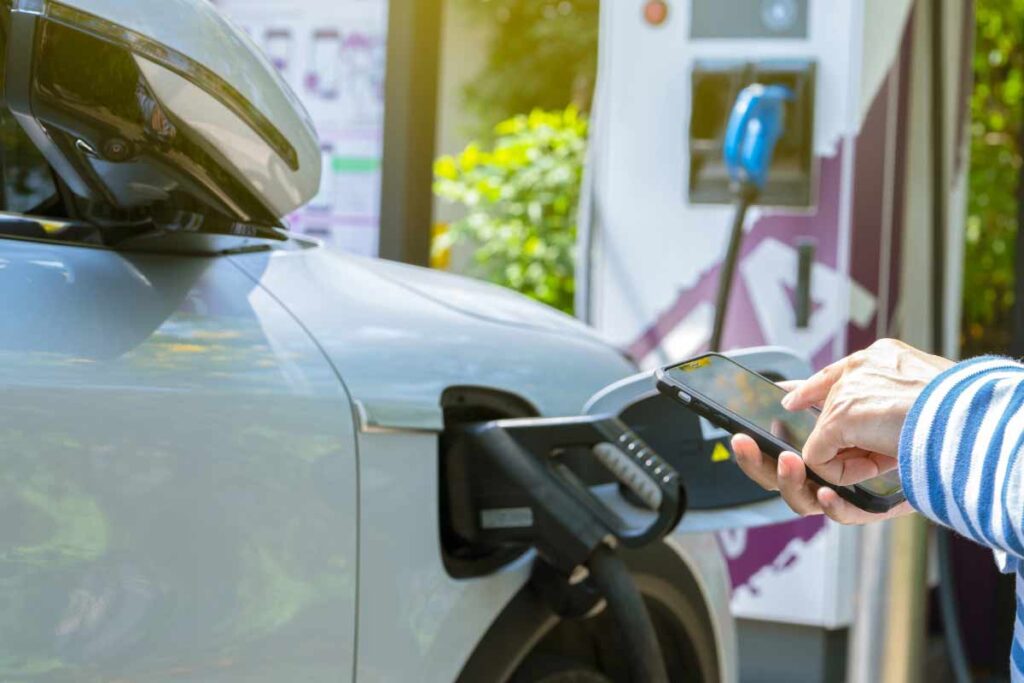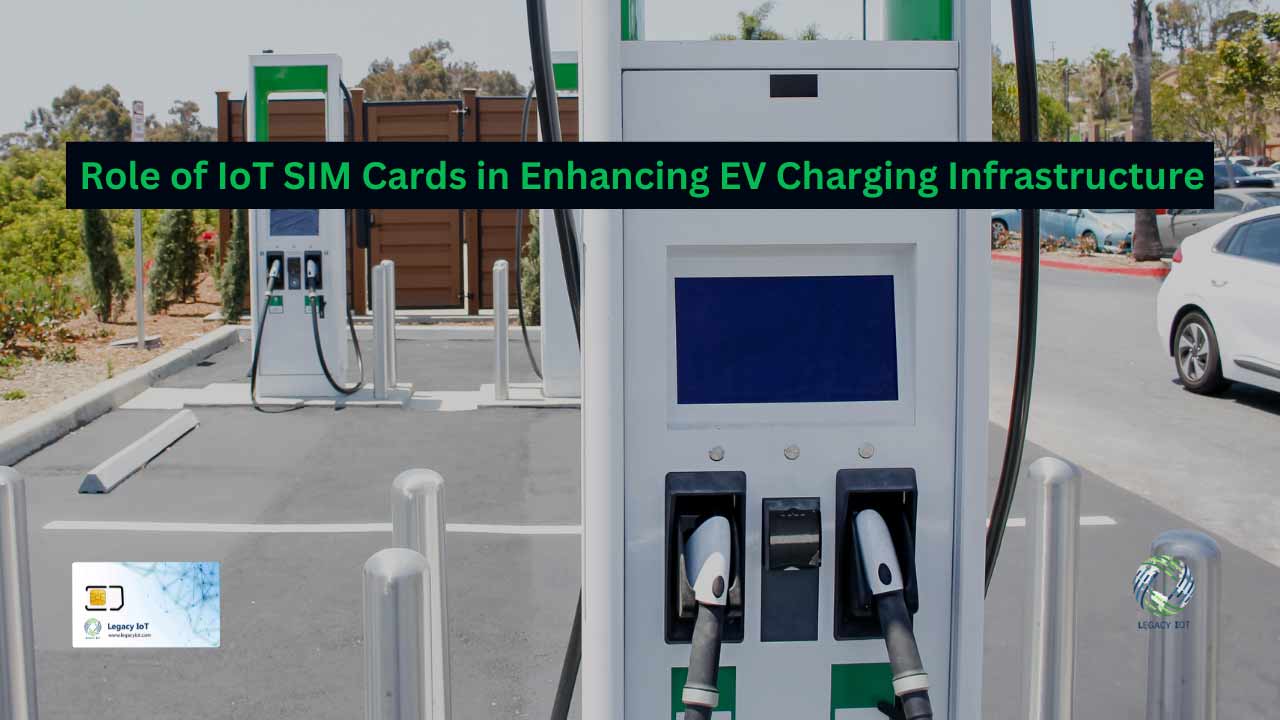Introduction
The rise of electric vehicles (EVs) is accelerating the need for efficient and connected EV charging infrastructure. IoT SIM cards for EV charging play a crucial role in ensuring seamless communication, real-time data transmission, and intelligent management of charging networks.

By integrating IoT technology, operators can enhance performance, minimize downtime, and offer an improved user experience. Additionally, as governments push for widespread EV adoption, the need for reliable and scalable charging infrastructure becomes more critical than ever.
1. Real-Time Data Transmission for Seamless Operation
Reliable connectivity is essential for EV charging stations to function efficiently. IoT SIM cards enable real-time data transmission, allowing charging stations to communicate with central management systems instantly. This connectivity provides updates on station availability, usage statistics, and energy consumption patterns. Drivers benefit from access to live data on charging point availability via mobile apps, reducing wait times and improving convenience. This real-time data also helps city planners optimize charging station placements based on demand.
Additionally, real-time data transmission supports automatic fault detection and reporting. If a charging station encounters a technical issue, the system can immediately alert maintenance teams, reducing repair time and improving service reliability. This predictive maintenance feature ensures that EV drivers encounter fewer disruptions and that charging networks remain operational at all times.
2. Remote Monitoring and Maintenance
IoT SIM cards enable remote monitoring of EV charging stations, allowing operators to track station performance, identify technical issues, and perform software updates without the need for on-site inspections. This remote capability helps in reducing maintenance costs and minimizing downtime, ensuring a smooth and efficient charging experience for users.
Additionally, predictive maintenance powered by IoT analytics can detect potential failures before they occur, preventing costly repairs and service interruptions. By analyzing usage patterns and performance trends, operators can proactively schedule maintenance, avoiding sudden breakdowns. Remote diagnostics further streamline maintenance operations, enabling technicians to troubleshoot issues in real time without needing to visit each charging station physically.
3. Optimized Energy Management and Cost Efficiency
Energy management is critical for EV charging networks, and IoT-enabled smart energy monitoring optimizes resource usage. By collecting and analyzing data on energy consumption, operators can implement demand response strategies and dynamic pricing models. This not only helps balance grid loads but also reduces operational costs by optimizing power distribution during peak and off-peak hours.
Integrating renewable energy sources, such as solar or wind, with IoT-driven energy management further enhances sustainability and cost efficiency. Smart grids equipped with IoT SIM cards can automatically allocate power between charging stations and energy storage systems, ensuring optimal usage of renewable energy. This approach reduces reliance on fossil fuels and supports global sustainability goals by promoting greener charging networks.
4. Enhanced User Experience and Smart Features
The integration of IoT connectivity in EV charging enhances the user experience through features such as:
- Remote reservation of charging slots
- Mobile payment integration
- Real-time charging notifications
- Personalized loyalty programs
These features ensure convenience for EV owners and promote higher adoption of electric vehicles. Additionally, IoT-enabled smart charging stations can remember user preferences, offering tailored charging speeds and payment options for frequent users.
Seamless app-based control also allows EV owners to monitor their charging sessions remotely, adding a layer of transparency and control over energy consumption. Furthermore, real-time feedback and interactive customer support services enhance the overall user experience by addressing concerns quickly and efficiently.
5. Robust Security and Compliance
With increased connectivity comes the need for secure data transmission. M2M SIM Cards or IoT SIM cards use encryption protocols to protect user data, financial transactions, and charging station networks. Ensuring compliance with industry security standards builds trust among users and promotes the wider adoption of EV charging infrastructure.
Furthermore, multi-factor authentication and blockchain-based transaction tracking can add additional layers of security, preventing fraud and unauthorized access. Secure IoT networks ensure that sensitive charging data remains protected from cyber threats, making EV charging a safer and more reliable process.
6. Scalability and Future-Ready Networks
The modular nature of IoT SIM cards allows for scalability and flexibility in EV charging networks. As EV adoption rises, new charging stations can be seamlessly added without extensive infrastructure changes. This adaptability ensures that charging networks can grow to meet increasing demand, supporting the expansion of smart cities and sustainable transportation.
With 5G integration, future EV charging stations will benefit from ultra-low latency connectivity, further improving data accuracy and real-time decision-making. 5G-enabled IoT SIM cards will allow charging stations to support advanced AI-powered grid management systems, enhancing energy distribution and vehicle-to-grid (V2G) capabilities. These advancements will contribute to more efficient and autonomous EV charging operations in the years to come.
7. The Role of Legacy IoT in the Future of EV Charging
As the demand for EV charging infrastructure grows, Legacy IoT continues to drive innovation in the sector. By providing cutting-edge IoT connectivity solutions, Legacy IoT ensures seamless data transmission, advanced analytics, and secure networks for EV charging stations worldwide. Their solutions empower businesses and municipalities to create efficient, reliable, and scalable EV charging ecosystems that meet future mobility demands.
Legacy IoT also collaborates with technology partners to develop next-generation IoT-enabled charging solutions. These include AI-based grid optimization, enhanced cybersecurity measures, and cloud-based analytics for better decision-making. As EV technology evolves, Legacy IoT remains at the forefront of connectivity advancements, ensuring that charging networks remain intelligent, efficient, and secure.
Conclusion
The integration of IoT SIM cards is transforming EV charging infrastructure, making it smarter, more efficient, and user-friendly. From real-time data transmission to remote monitoring, optimized energy management, and enhanced security, IoT technology is essential for the growth of the EV ecosystem. Legacy IoT is at the forefront of this revolution, providing advanced connectivity solutions to power the future of electric mobility.
With increased scalability, improved security, and seamless real-time monitoring, IoT SIM cards are unlocking new possibilities in the EV sector. As technology continues to advance, businesses and municipalities that adopt these solutions will lead the way in creating a more connected and efficient EV charging network.





